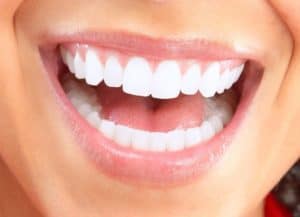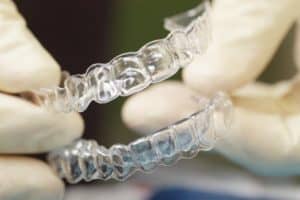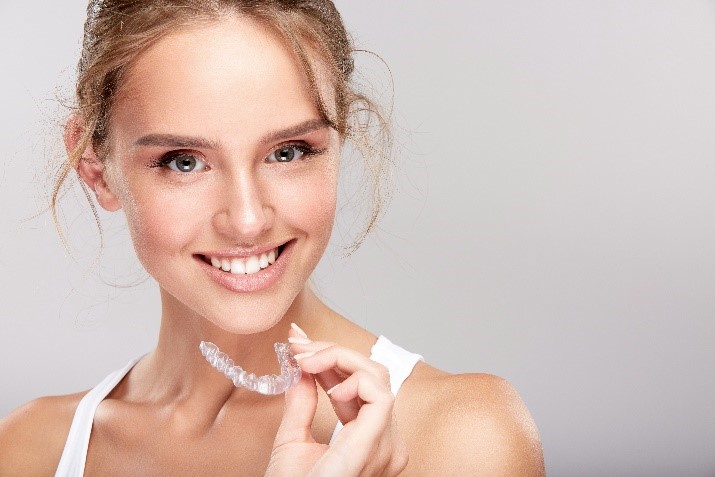Invisalign In Toledo & Sylvania
An Invisible Way to Straighten Teeth

For many years, orthodontic treatment required wearing bulky, uncomfortable metal braces and wires. The shame and embarrassment of sporting these bulky metal braces prevented many people from seeking the beautifully straight smile they desired.
Invisalign was created for the patient that wants straighter teeth without wearing visible, uncomfortable metal braces. Invisalign patients wear a series of clear, plastic aligners that gradually shift teeth into the desired position and alignment. Because of the nature of the aligners, patients can maintain a normal looking smile while simultaneously straightening their teeth.
At Dental Health Associates, our dentists are thoroughly trained and extensively experienced with Invisalign treatment. We enjoy helping our patients transform their smiles easily and comfortably!
What Invisalign Can Correct
Invisalign corrects cases of minor tooth misalignment or poor spacing, where the problem is mostly cosmetic. This includes small spaces between the teeth, crowding of the teeth, an overbite (i.e., the upper teeth bite over the lower teeth), and a crossbite (i.e., the upper and lower jaws are misaligned).
Patients that have substantial structural issues with the teeth or problems with the bite are typically better suited for traditional braces or another orthodontic alternative.
Advantages of the Invisalign System
There are many reasons why patients prefer Invisalign to traditional braces, including the following:
- Aligners fit comfortably and don’t irritate the inside of the mouth
- Aligners don’t disrupt speech
- Aligners can be removed to eat so patients can enjoy all of their favorite foods
- Aligners are inconspicuous and virtually undetectable in the mouth
- Total treatment time is usually shorter than other orthodontic treatments
Treatment Details

Invisalign aligners are custom-fabricated to the exact specifications of the patient. No two treatment plans are precisely alike.
The first step to of Invisalign treatment is to capture information about the teeth’s current position. The dentist takes photographs and digital impressions that are used to create a three-dimensional “map” of the teeth’s planned movement. The map charts the teeth’s original position through Invisalign treatment to their final position. This information is then sent to the dental laboratory that constructs the series of customized aligners.
The patient receives their first set of upper and lower aligners and should wear them for 20 to 22 hours per day (removing them to eat and clean). The aligners put gentle pressure on the teeth to move them into the correct alignment and position. Patients may have a slight adjustment period, getting used to the way the aligners feel, but they usually don’t experience discomfort. They can eat, speak and smile normally while wearing the aligners.
After two to four weeks, that set of aligners is swapped out for the next set in the series. This repeats until the teeth have shifted into the desired position and alignment.
Invisalign patients are supervised by a dentist throughout treatment. The dentist periodically checks the progress of treatment and examines the teeth and bite for any potential problems.
Total treatment time varies by patient, but many Invisalign patients are able to complete treatment in less than a year.
Invisalign FAQs
How long does Invisalign take?

You are likely to see a difference in the alignment of your teeth within a few weeks, but the total course of treatment generally lasts about a year. Some patients only need six months, while others require two years, depending on the starting condition of the teeth. You can help to accelerate the process by wearing your aligners as often as possible — at least 20 hours per day.
Is it easy to keep Invisalign aligners clean?
The ability to remove your aligners when you eat and drink goes a long way toward keeping your aligners clean. Each day, aligners should be brushed with toothpaste and rinsed in room-temperature water to keep them fresh. Since aligners are swapped out periodically (roughly every two weeks), you should be on to the next aligner long before the current one declines in quality.
Does my insurance cover Invisalign?
Many dental insurance plans cover at least part of the cost of Invisalign, much like it does braces. You will need to check your individual plan to determine the amount or percentage of money the policy covers for Invisalign. During a consultation, our staff can help review what you will expect to have to pay out of pocket so that you can make an informed decision on your treatment plan.
Learn More about Invisalign
If you want a straighter, more beautiful smile without bulky metal braces, the team at Dental Health Associates can help. To learn more about straightening teeth invisibly with the Invisalign system, please contact our team and request an informational consultation.


